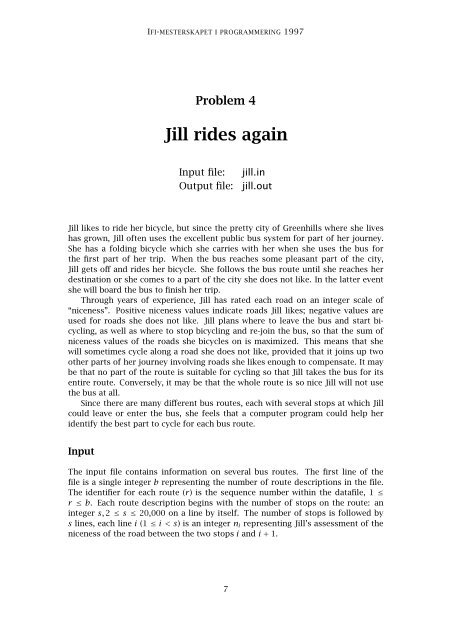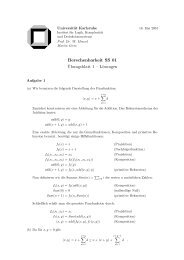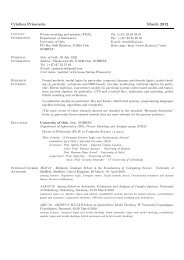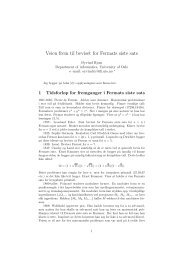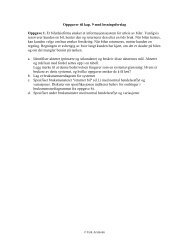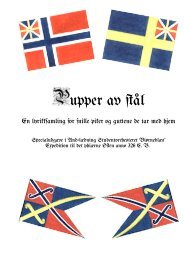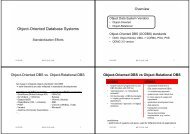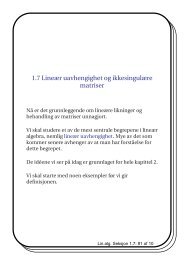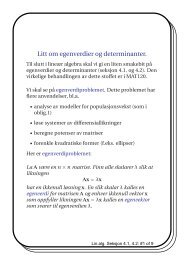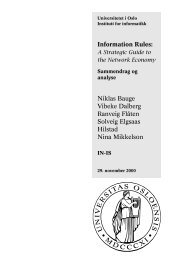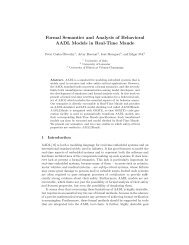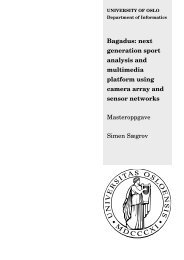Jill rides again - IfI
Jill rides again - IfI
Jill rides again - IfI
Create successful ePaper yourself
Turn your PDF publications into a flip-book with our unique Google optimized e-Paper software.
IFI-MESTERSKAPET I PROGRAMMERING 1997<br />
Problem 4<br />
<strong>Jill</strong> <strong>rides</strong> <strong>again</strong><br />
Input file: jill.in<br />
Output file: jill.out<br />
<strong>Jill</strong> likes to ride her bicycle, but since the pretty city of Greenhills where she lives<br />
has grown, <strong>Jill</strong> often uses the excellent public bus system for part of her journey.<br />
She has a folding bicycle which she carries with her when she uses the bus for<br />
the first part of her trip. When the bus reaches some pleasant part of the city,<br />
<strong>Jill</strong> gets off and <strong>rides</strong> her bicycle. She follows the bus route until she reaches her<br />
destination or she comes to a part of the city she does not like. In the latter event<br />
she will board the bus to finish her trip.<br />
Through years of experience, <strong>Jill</strong> has rated each road on an integer scale of<br />
“niceness”. Positive niceness values indicate roads <strong>Jill</strong> likes; negative values are<br />
used for roads she does not like. <strong>Jill</strong> plans where to leave the bus and start bicycling,<br />
as well as where to stop bicycling and re-join the bus, so that the sum of<br />
niceness values of the roads she bicycles on is maximized. This means that she<br />
will sometimes cycle along a road she does not like, provided that it joins up two<br />
other parts of her journey involving roads she likes enough to compensate. It may<br />
be that no part of the route is suitable for cycling so that <strong>Jill</strong> takes the bus for its<br />
entire route. Conversely, it may be that the whole route is so nice <strong>Jill</strong> will not use<br />
the bus at all.<br />
Since there are many different bus routes, each with several stops at which <strong>Jill</strong><br />
could leave or enter the bus, she feels that a computer program could help her<br />
identify the best part to cycle for each bus route.<br />
Input<br />
The input file contains information on several bus routes. The first line of the<br />
file is a single integer b representing the number of route descriptions in the file.<br />
The identifier for each route (r) is the sequence number within the datafile, 1 ≤<br />
r ≤ b. Each route description begins with the number of stops on the route: an<br />
integer s,2 ≤ s ≤ 20,000 on a line by itself. The number of stops is followed by<br />
s lines, each line i (1 ≤ i
Example<br />
3<br />
3<br />
-1<br />
6<br />
10<br />
4<br />
-5<br />
4<br />
-3<br />
4<br />
4<br />
-4<br />
4<br />
-5<br />
4<br />
-2<br />
-3<br />
-4<br />
Output<br />
IFI-MESTERSKAPET I PROGRAMMERING 1997<br />
For each route r in the input file, your program should identify the beginning bus<br />
stop i and the ending bus stop j that identify the segment of the route which yields<br />
the maximal sum of niceness, m = ni + ni+1 +···+nj−1. If more than one segment<br />
is maximally nice, choose the one with the longest cycle ride (largest j −i). To break<br />
ties in longest maximal segments, choose the segment that begins with the latest<br />
stop (highest i). For each route r in the input file, print a line in the form:<br />
The nicest part of route r is between stops i and j.<br />
However, if the maximal sum is negative, your program should print:<br />
Example<br />
Route r has no nice parts.<br />
The example input given above should produce the following output:<br />
The nicest part of route 1 is between stops 2 and 3<br />
The nicest part of route 2 is between stops 3 and 9<br />
Route 3 has no nice parts<br />
8


